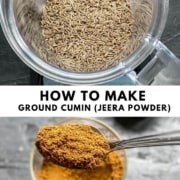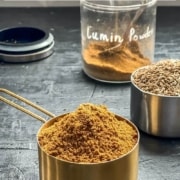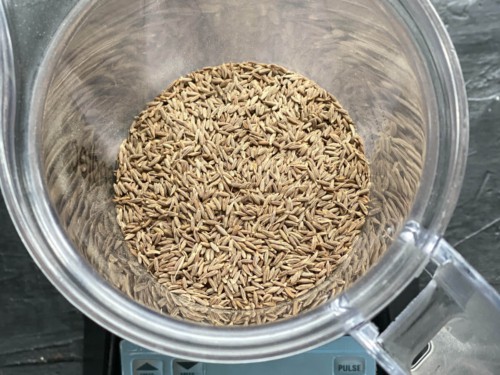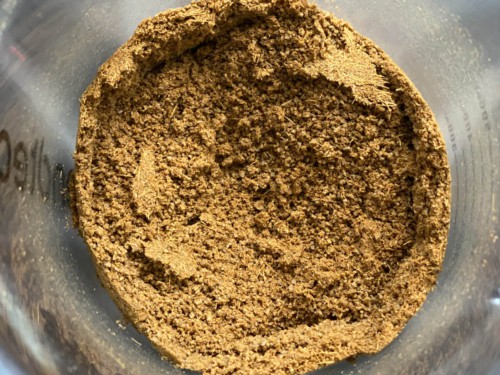How to make ground cumin (jeera powder)
Note: This post contains affiliate links. As an Amazon Associate I earn from qualifying purchases.
Using homemade cumin powder (jeera powder) makes a world of difference when it comes to cooking Indian food at home. The superior end results will convince you to never get store-bought ground cumin again. All you need is one ingredient and 5 minutes – it is that easy!
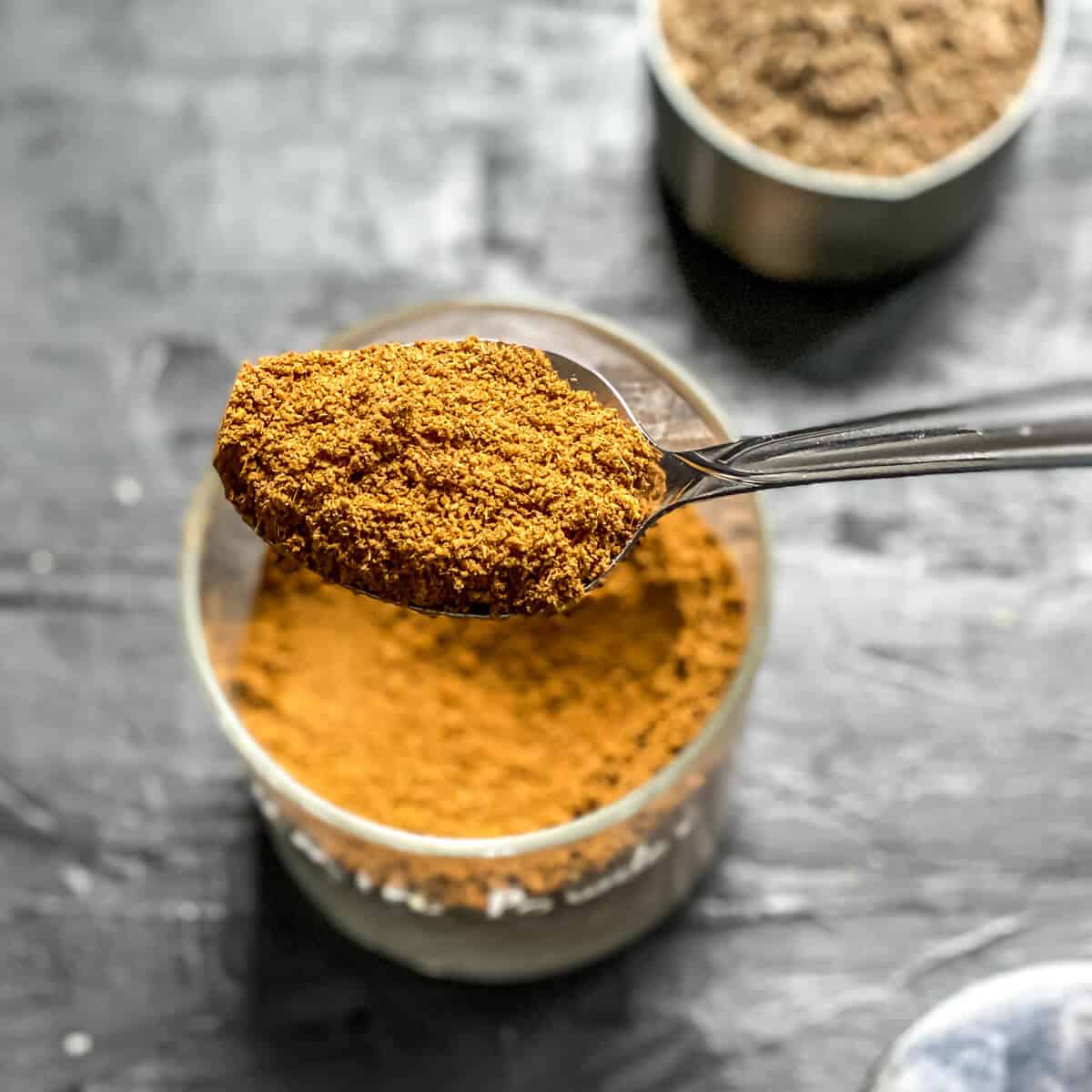
Creating delicious dishes in your own home is not only possible, but it’s simple. When you keep quality ingredients on hand, it’s easy to enhance the flavor of your dishes. Using freshly ground spices is a trick that anyone can use to instantly make their food 100% better.
This recipe for jeera powder is the easiest way to get started using freshly ground spices in your kitchen. It can be made in bulk and stored in your pantry for several months. Adding a punch of warm, nutty flavor is just a few steps away when you keep this easy homemade ground cumin on hand.
Like my homemade roasted cumin powder (bhuna jeera), this simple recipe uses just 1 ingredient and is much cheaper to make in your own kitchen.
All you’ll need is a good quality spice grinder or blender, and some cumin seeds to get started. In less than 5 minutes, you’ll have a fragrant and flavorful batch of ground cumin seasoning that is perfect for adding to your favorite curry recipes.
In addition to Indian curries, cumin powder is extremely popular in Mexican and Middle Eastern cuisines.
What are cumin seeds?
Cumin seeds are dried and harvested from the Cuminum cyminum, a member of the parsley family. It is primarily grown for its seeds, which are used for cooking or ground into a fine powder that is commonly known as ground cumin or cumin powder.
Most pronounce cumin as KYOO-MIN but KUH-MIN and KOO-MIN are also acceptable.
Fun fact: India produces and consumes the most cumin in the world.
Alternate names
Most often referred to as cumin, the seeds and resulting powder also have other names that are commonly used all over the world. A few of the most popular come from areas where cooking with cumin is very popular.
In India, it is commonly referred to as Jeera or Zeera (its Hindi name). In Latin America, it’s known as Comino (its Spanish name).
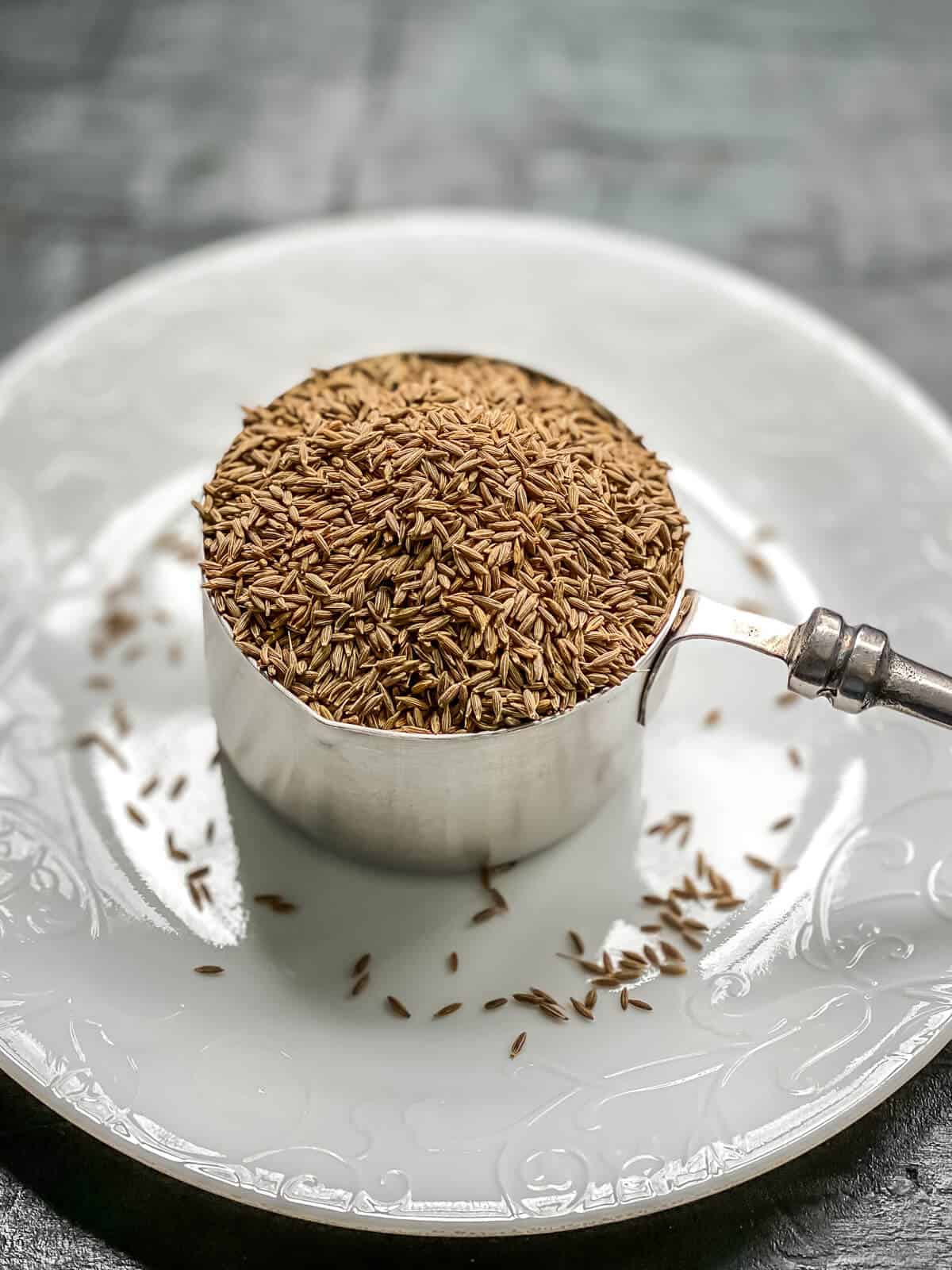
Where does cumin come from
While cumin was first cultivated and used in Western Asia, it’s now most popular and widely grown in India. It is also grown in much of the Middle East, Mexico, Argentina, and even some Eastern European countries like Ukraine.
India is the largest producer and consumer, which makes sense because many Indian dishes use cumin seeds!
Health benefits
Cumin, like many spices, contains many health benefits. In addition to being high in vitamin A, calcium, and iron, cumin has also been shown to help with weight control and digestion.
Read more: Health Benefits of Cumin
What is cumin powder?
Cumin powder is the dried and ground seeds of the Cuminum cyminum plant. Both the seeds and ground powder are used to flavor many popular dishes. Cumin is a common spice used in curries.
Ground cumin comes in two forms – roasted and unroasted. Roasted cumin powder is more often than not used as a finishing spice whereas cumin powder is used while cooking.
What flavor does cumin add?
Cumin adds a strong, signature flavor that can be described as earthy, and warm. The particular flavor varies greatly based on what form you use: whole cumin seeds, cumin powder, or roasted cumin powder.
Cumin seeds, when used whole, are mostly used for tempering (where whole seeds are added to hot oil to infuse flavor) and of course, to make ground cumin. The seeds have a relatively mild flavor when compared to the powdered versions of cumin.
Cumin powder is stronger in flavor than whole cumin seeds and has the signature warmth and slight nuttiness that is common with all forms of cumin. It is the most commonly used form in America.
Roasted cumin powder – The most intensely flavored is the powdered and roasted form, which is also known as Bhuna Jeera. This is most often used as a finishing spice, being added to the dish towards the end. It is nuttier, more earthy, and concentrated in flavor as compared to the unroasted cumin powder.
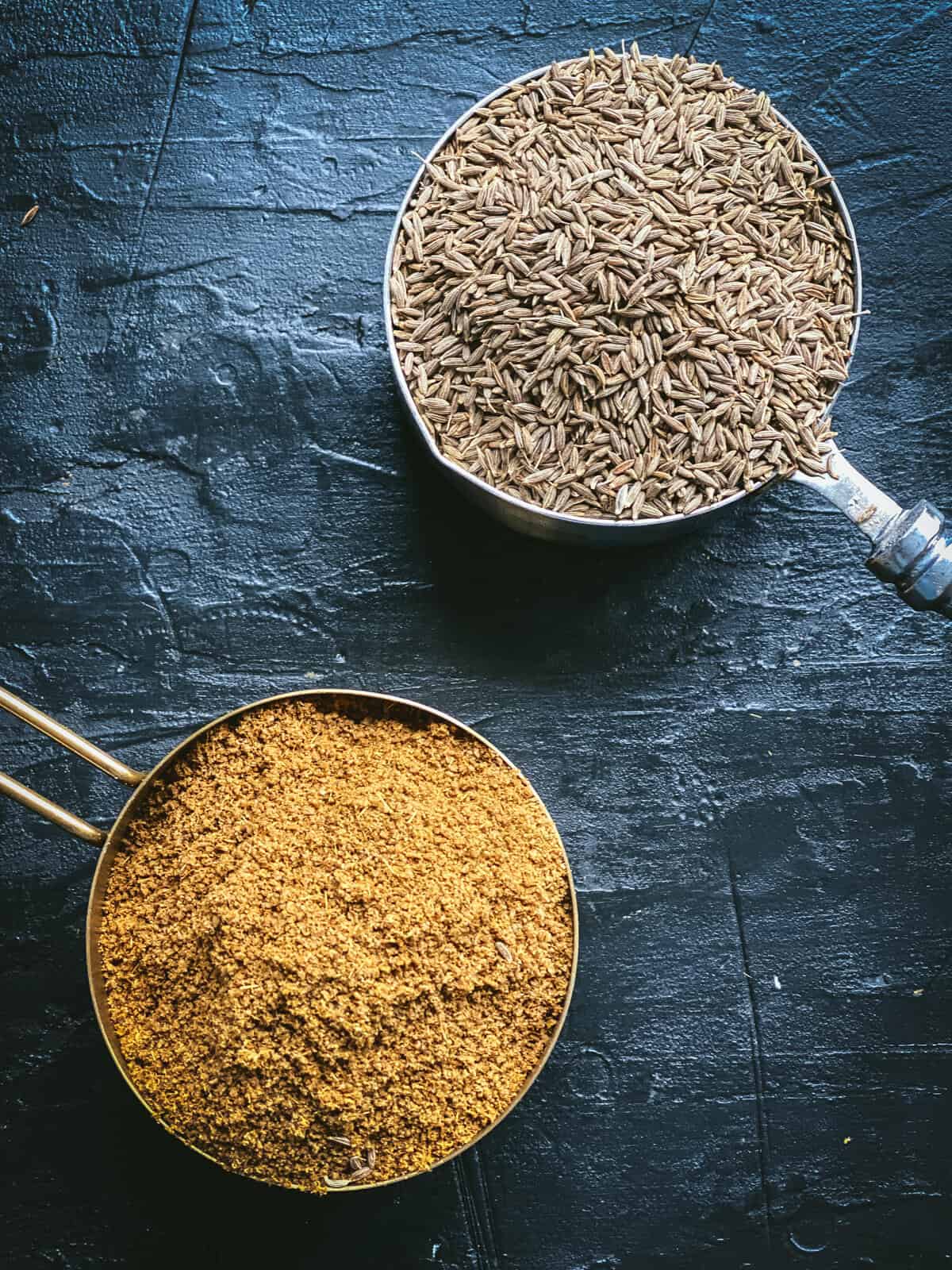
Cooking with cumin seeds vs. ground cumin
It is very common to use cumin seeds in Indian cooking in their whole form. This is done by tempering, which is adding the whole seeds to hot oil to infuse the oil with their flavor. If the recipe calls for tempering, you will need to use cumin seeds instead of cumin powder or roasted cumin powder.
Cumin powder is used when you want to infuse the dish with the flavor of cumin but do so quickly without any additional steps or toasting. It is a quick and easy way to add flavor to your dish without any additional steps and provides a slightly sweeter flavor.
Roasted cumin powder (also known as Bhuna Jeera) is used as a finishing spice in raitas, chaat, and lassi (yogurt drink).
As you can see, each type of cumin has its distinctive qualities and is used in very different ways. You can see why I typically keep all three in my pantry cupboard.
Where to buy
While making homemade cumin powder is very simple, you may be wondering where you can buy it to keep on hand at all times. Good news! Ground cumin is widely available in the spice aisle at every grocery store and supermarket chain, as well as online retailers. You can purchase it in bulk at your local Indian grocery, and even many larger supermarkets.
That being said, I do prefer the use of homemade cumin powder. The flavor is very fresh and it is less expensive.
Why make homemade cumin powder?
While the store-bought version often does the trick, this homemade jeera powder (ground cumin) is far better than anything you can buy in a store. Here’s why –
- Homemade ground spices are more potent (meaning the flavor is stronger than store-bought and you don’t have to use as much).
- Fresh – You don’t truly know how long the spices on the shelves of the grocery store have been sitting there. When you make your own, you know they are fresh.
- Food tastes better – These fresh ground spices bring a better flavor than the store-bought making every dish you make all the better.
- No fillers – You know exactly what is in your fresh ground spices because you ground them yourself.
- Cheaper – Grinding your own spices is more cost-effective than buying the pre-made spices at the store.
Here’s what you need to make the recipe
Ingredient notes
- Cumin seeds – Try to find the freshest seeds available. Avoid any dull, or overly dry-looking seeds, as they are likely older seeds with less flavor.
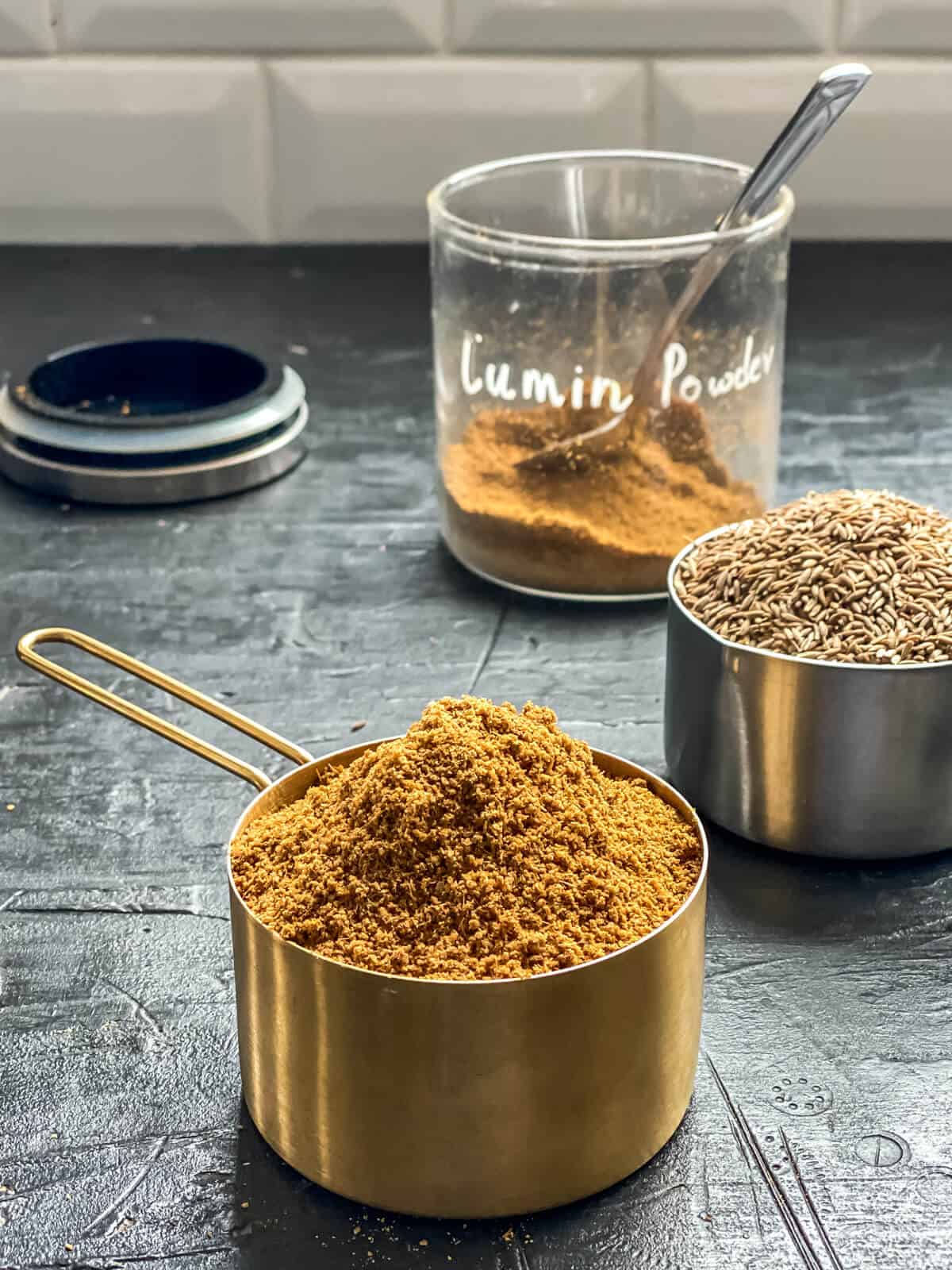
Tools
- Heavy bottomed pan
- Spice grinder or blender – to make grinding the cumin seeds into powder easy, a spice grinder or a blender is a must.
TIPS
- Make a smaller batch – The potency of spice mixes go down as they age so make a batch that is sufficient for a month or two.
- More potent than store-bought so use it sparingly.
- Buy organic cumin seeds, if available. Check for the manufacturing date when buying packaged ones.
- Store in a cool, dry place and away from direct sunlight.
- Always use a clean, dry spoon while scooping out the ground cumin.
Storage tips
Cumin seeds last for a year whereas ground cumin is best used within a couple of months. Make sure to store the ground spice in your spice cabinet or a cool and dry place.
Freezing instructions: To prolong shelf life, keep the whole seeds in the freezer in an air-tight container. To make ground cumin seasoning from the frozen seeds, allow them to come to room temperature. Pat the seeds dry with a paper towel, roast them to get rid of any moisture and grind in a blender until a fine powder remains.
Variations to try
You can roast the cumin seeds as I have in this bhuna jeera powder or roasted cumin powder recipe. It makes the flavor more intense.
How to use ground cumin in recipes
After cooling and blending, this homemade ground cumin is ready to use. Add it to spice blends, marinade, curries, rice dishes, soups, and stews. Simply measure the amount you need for the recipe and add based on the recipe directions.
Recipes that use cumin powder
If you’re interested in making your own ground cumin powder, you may be wondering what kind of recipes you can use it in. I have many on my blog, but here are a few of my favorites:
- Indian inspired chicken lettuce wraps
- Aloo gobi (cauliflower and potato curry)
- Punjabi rajma masala (kidney beans curry)
- Instant Pot moong bean curry
Cumin powder substitute
If you are out of cumin powder you may be wondering what you can use in its place. Whole cumin seeds added to a blender or spice grinder make a quick and easy batch of homemade ground cumin. But if you are in a rush, here are a few substitutions you can try but remember they’ll not be an exact match.
- 1 teaspoon ground coriander = 1 teaspoon cumin powder
- 1/2 teaspoon garam masala = 1 teaspoon cumin powder
- 1/2 teaspoon taco seasoning = 1 teaspoon cumin powder
- 1/2 teaspoon curry powder = 1 teaspoon cumin powder

FAQs about ground cumin
Most storebought cumin powders are made from unroasted cumin seeds. Roasting cumin seeds is not necessary but doing so does increase the shelf life and gives the ground cumin a more intense flavor.
Although cumin is often used with other spices and seasonings that can be “hot”, on its own, it’s not very spicy. It does have a deep, intense flavor that is instantly recognizable, but it’s not “spicy” in the same way something like ground cayenne or chipotle peppers would be.
If you would like to make homemade cumin powder without a blender, you can use a heavy mortar and pestle, or you can use a rolling pin with the cumin seeds in a heavy-duty plastic freezer bag.
While cumin seeds are often confused with caraway seeds, they are very different. Cumin seeds are often toasted or ground to be used in Indian, Mexican, and Middle Eastern cuisine, while caraway seeds are small and most often used in Central and Eastern European cuisine. Cumin is often used in highly flavored, savory dishes, while caraway is most often used in baked goods and sauerkraut.
Since cumin is made from the seeds of its mother plant, it is considered a spice rather than an herb.
While cumin has a signature flavor, some common substitutes include caraway and coriander.
No, cumin is not the same as cayenne pepper. Cayenne is made from dried and ground cayenne peppers, while cumin is made from the seed of its mother plant, which is a member of the parsley family. Cayenne is also very hot, while cumin is not, and instead has an intense flavor.
Other spice mixes you should make at home
If you are someone who likes to make their own homemade spice blends, I have a few tried and tested recipes –
- Rasam Powder – Check out this easy recipe for rasam powder – a zesty, aromatic spice blend from South India that makes rasam (a tangy lentil-based soup) taste so darn good.
- Aromatic and Easy Garam Masala Powder – Homemade garam masalas are the best – flavorful and potent. Use them for your North Indian curries and biryanis to make it aromatic.
- Kundapur Masala Powder (Taal powder) – This spice blend will help you cut your cooking time for most Mangalorean dishes substantially – that’s why most folks stock it at home.
- Taco seasoning – Skip the storebought jars and learn how to make your own Mexican spice blend in less than 5 minutes!
Cumin (jeera) powder recipe
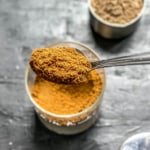
Cumin (jeera) powder
Equipment
Ingredients
- 1 cup cumin seeds jeera
Instructions
- Add the cumin seeds to a blender.

- Blend to a fine powder.

- Store in an air-tight container in a cool, dry place for about 3-4 months.
Disclaimer: Approximate nutritional information is provided as a courtesy and can vary depending on the exact ingredients/brands used. If you have health issues, please work with a registered dietician or nutritionist.

